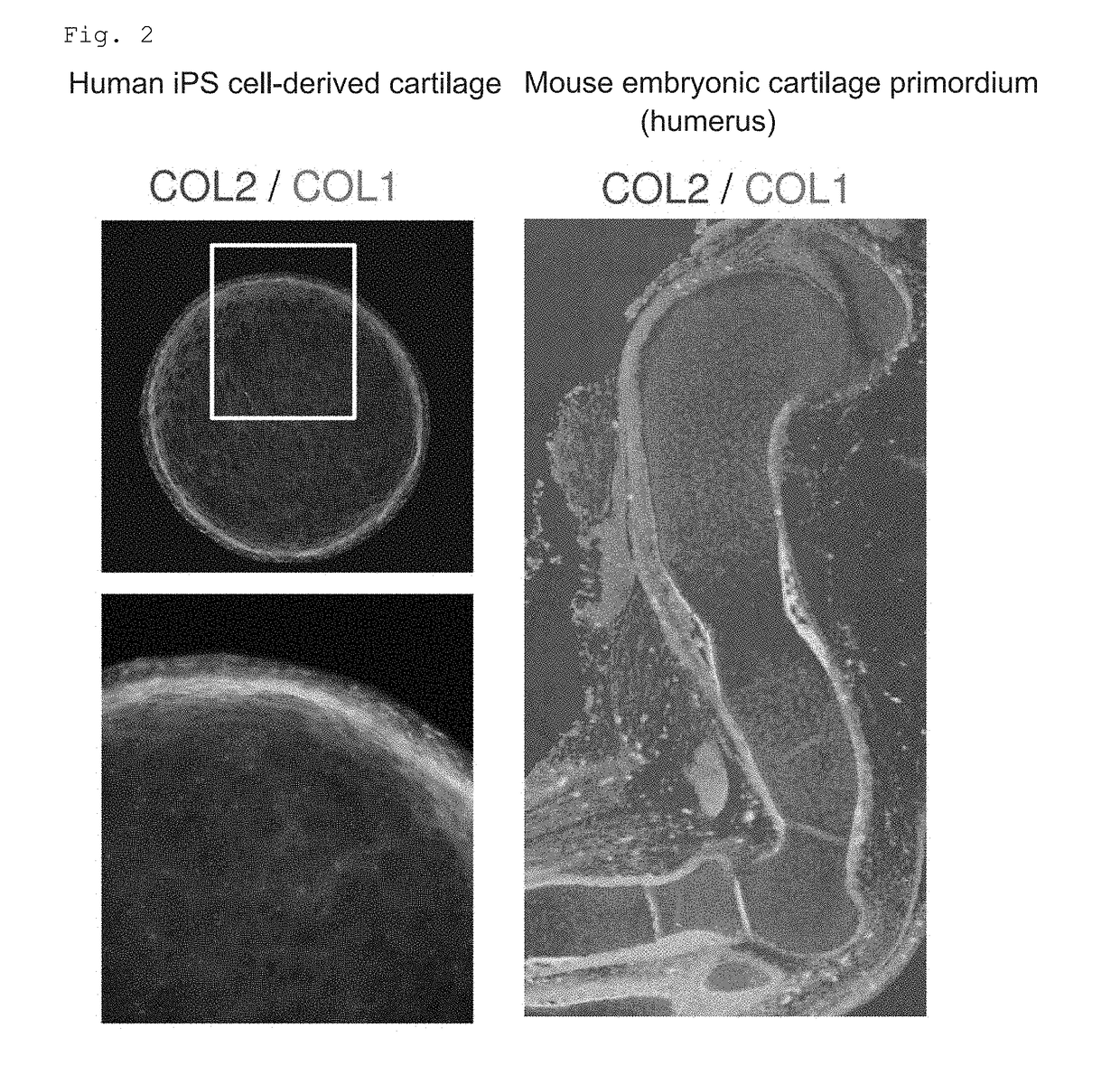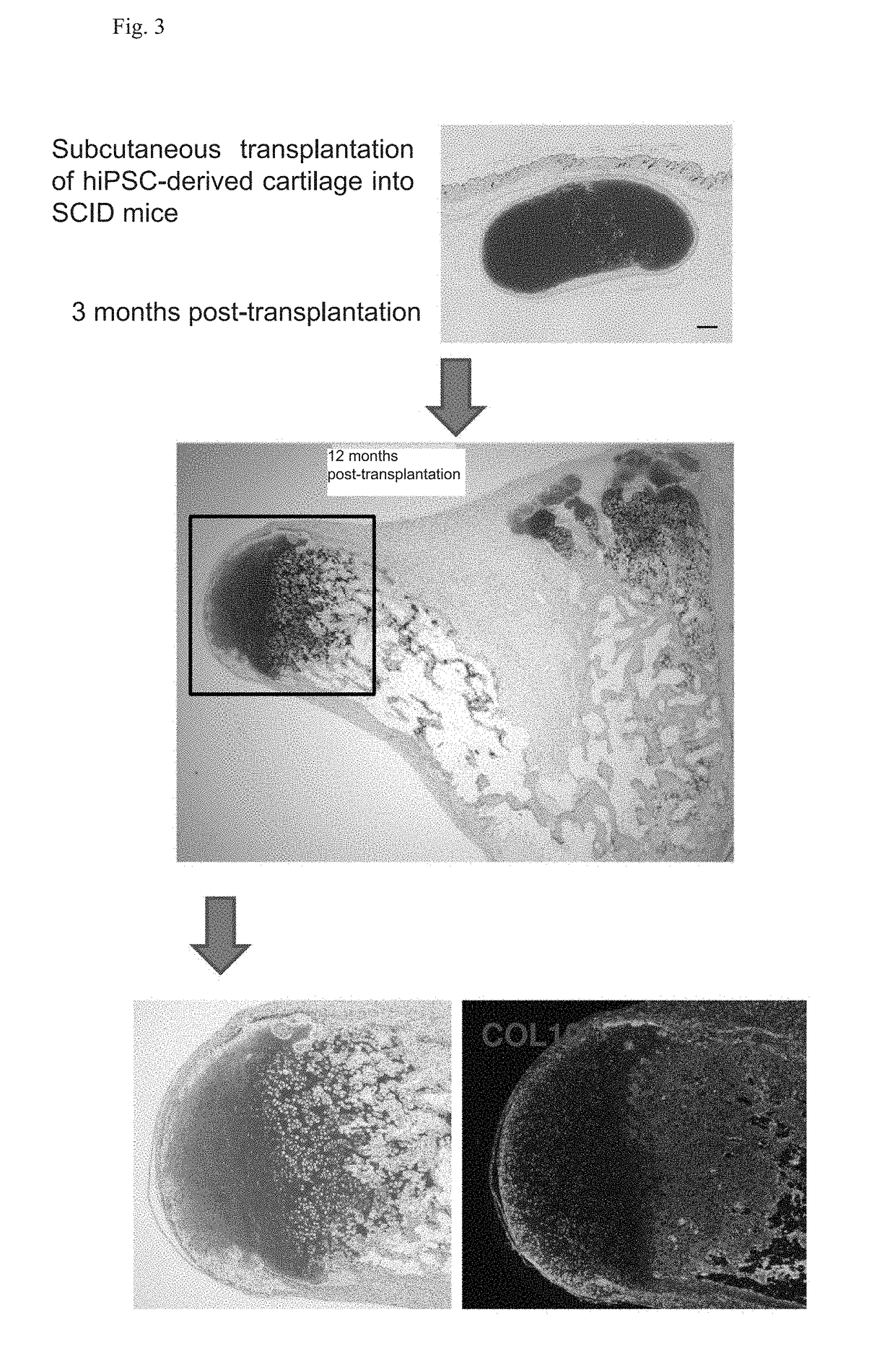Novel method for chondrogenic induction
a chondrogenic induction and chondrogenesis technology, applied in the direction of prosthesis, skeletal/connective tissue cells, drug compositions, etc., can solve the problems of limited size of damage sites that can be treated by transplantation, lack of cartilage tissue, damage that will deteriorate without repair treatment, etc., to achieve stable induction of pluripotent differentiation and simple steps
- Summary
- Abstract
- Description
- Claims
- Application Information
AI Technical Summary
Benefits of technology
Problems solved by technology
Method used
Image
Examples
example 1
Human iPS Cells
[0074]The 1231A3 cell line, which was established by the method described in Nakagawa M, et al., Sci Rep. 4:3594 (2014), was provided from the Center for iPS Cell Research and Application, Kyoto University, and was used as human iPS cells.
[0075]The human iPS cells were incubated with 0.5×TrypLE Select, and then detached using a cell scraper. The number of the cells was counted, and 1.0×106 to 2.0×106 cells were transferred to a 30-mL bioreactor (BWV-S03A, ABLE Corporation). To the bioreactor, 30 mL of StemFit AK03 (Ajinomoto) supplemented with 10 nM Y-27632 (Wako) was added, and the cells were cultured under the conditions of 37° C. and 5% CO2 for 5 days with stirring using a 6-cm magnetic stirrer (BWS-S03NOS-6, ABLE Corporation) at a rotation speed of 55 rpm. As a result, iPS cell clusters of 50 to 300 μm in diameter were obtained.
Chondrogenic Induction
[0076]The iPS cell clusters obtained by the above method were collected, and the whole or half of them were seeded o...
example 2
Human iPS Cells
[0080]The 1231A3 cell line, which was established by the method described in Nakagawa M, et al., Sci Rep. 4:3594 (2014), was provided from the Center for iPS Cell Research and Application, Kyoto University, and was used as human iPS cells.
[0081]The human iPS cells were incubated with 0.5×TrypLE Select, and then detached using a cell scraper. The number of the cells was counted, and 0.5×107 to 1.0×107 cells were transferred to a 100-mL bioreactor (BWV-S10A, ABLE Corporation). To the bioreactor, 100 mL of StemFit AK02N (Ajinomoto) supplemented with 10 nM Y-27632 (Wako) was added, and the cells were cultured under the conditions of 37° C. and 5% CO2 for 4 to 7 days with stirring using a magnetic stirrer (BWS-S03NOS-6, ABLE Corporation) at a rotation speed of 60 rpm. As a result, iPS cell clusters of 50 to 300 μm in diameter were obtained.
Chondrogenic Induction
[0082]The iPS cell clusters obtained by the above method were collected and seeded on four to twelve 10-cm suspen...
example 3
Human iPS Cells
[0085]The Ff-I01 cell line, which was established by the method described in Nakagawa M, et al., Sci Rep. 4:3594 (2014), was provided from the Center for iPS Cell Research and Application, Kyoto University, and was used as human iPS cells.
[0086]The human iPS cells were incubated with 0.5×TrypLE Select, and then detached using a cell scraper. The number of the cells was counted, and 0.5×107 to 1.0×107 cells were transferred to a 100-mL bioreactor (BWV-S10A, ABLE Corporation). To the bioreactor, 100 mL of StemFit AK03N (Ajinomoto) supplemented with 10 nM Y-27632 (Wako) was added, and the cells were cultured under the conditions of 37° C. and 5% CO2 for 4 to 7 days with stirring using a magnetic stirrer (BWS-S03NOS-6, ABLE Corporation) at a rotation speed of 60 rpm. As a result, iPS cell clusters of 50 to 300 μm in diameter were obtained.
Chondrogenic Induction
[0087]The iPS cell clusters obtained by the above method were collected and seeded on four to twelve 10-cm suspen...
PUM
| Property | Measurement | Unit |
|---|---|---|
| time | aaaaa | aaaaa |
| time | aaaaa | aaaaa |
| diameter | aaaaa | aaaaa |
Abstract
Description
Claims
Application Information
 Login to View More
Login to View More - R&D
- Intellectual Property
- Life Sciences
- Materials
- Tech Scout
- Unparalleled Data Quality
- Higher Quality Content
- 60% Fewer Hallucinations
Browse by: Latest US Patents, China's latest patents, Technical Efficacy Thesaurus, Application Domain, Technology Topic, Popular Technical Reports.
© 2025 PatSnap. All rights reserved.Legal|Privacy policy|Modern Slavery Act Transparency Statement|Sitemap|About US| Contact US: help@patsnap.com



